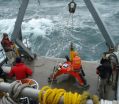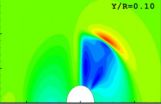(Press-News.org) Harnessing the power of ocean tides has long been imagined, but countries are only now putting it into practice. A demonstration project planned for Puget Sound will be the first tidal energy project on the west coast of the United States, and the first array of large-scale turbines to feed power from ocean tides into an electrical grid.
University of Washington researchers are devising ways to site the tidal turbines and measure their environmental effects. Brian Polagye, UW research assistant professor of mechanical engineering, will present recent findings this week in an invited talk at the American Geophysical Union's annual meeting in San Francisco.
Polagye and colleagues are involved in environmental monitoring before and during a planned deployment of two 30-foot-wide turbines in Admiralty Inlet, the main entrance to Washington state's Puget Sound.
"There really isn't that much information, anywhere, about the environmental effects of tidal turbines," Polagye said.
Although European countries have more experience with tidal energy devices, they are not as far ahead on environmental monitoring, Polagye said. He believes the Pacific Northwest installation will have the most comprehensive environmental monitoring of any tidal project so far.
"The results of this pilot project will help decide if this is an industry that has potential for going forward at the commercial scale, or if it stops at the pilot stage," Polagye said.
The Snohomish County Public Utility District, just north of Seattle, received a $10 million grant from the Energy Department for the tidal project now in the final phase of obtaining permits. The turbines would generate an average of 100 kilowatts of electricity, enough to power 50-100 Washington homes during the pilot phase.
"We want to monitor the effects of this particular project, but also understand the processes so we can apply the findings to other potential tidal energy sites," Polagye said.
To do this, the UW team must assess a new technology that operates in a little-explored environment.
"There's surprisingly little known about the oceanography of these very fast waters," said collaborator Jim Thomson, a UW assistant professor of civil and environmental engineering and an oceanographer in the UW's Applied Physics Laboratory. "These kinds of tidal channels where water is going very fast only happen in a few areas, and have not been well studied. The currents are so fast that it's hard to operate vehicles and maintain equipment. And it's too deep for conventional scuba diving."
The pilot site lies roughly 200 feet below the surface of Admiralty Inlet, where the UW team has measured currents of up to 8 knots, or 9 miles per hour.
One area of concern is how underwater noise generated by the turbines could affect marine mammals that use auditory cues to navigate and communicate with each other. Strong currents complicated the task of measuring how sound travels in the channel.
"When currents were more than about 2 knots the instruments are hearing considerable self-noise," Polagye said. "It's similar to when you're bicycling downhill and the air rushes past your ears."
Chris Bassett, a UW doctoral student in mechanical engineering, is testing approaches that would allow underwater microphones to work in fast-moving water.
UW researchers used sound from a Washington state ferry to learn how turbine noise would spread from the project site. The data suggest that Admiralty Inlet tends to lessen sound. This reduces the effect on animals' hearing, which is good, but it also means less noise for marine mammals to detect turbines and avoid them.
The UW team has been measuring currents continuously at the proposed site for almost two years, using a monitoring tripod the size of a small refrigerator. With added ballast for stability, the device weighs 850 pounds in water. Even so, it can barely stay put on the ocean floor.
The monitoring tripod holds instruments to track water quality, ambient noise, currents, temperature and salinity, and to record marine mammal calls and electronic tags on passing fish. This observational data will help determine precisely where to put the tidal turbines, and establish potential environmental effects once they are in the water.
So far, researchers say, the data support the notion that the Admiralty Inlet is well suited for a tidal energy installation from an engineering perspective. Once the turbines are in the water, likely in 2013, researchers will monitor environmental effects.
The Admiralty Inlet characterization is being conducted by the Northwest National Marine Renewable Energy Center, in which the UW leads research on tidal energy. Polagye and Thomson lead research on characterizing the physical attributes, such as currents and sound propagation. UW fisheries scientists recently received funding to test instruments for monitoring fish at the site, UW mechanical engineers are using computer models to see how pressure changes caused by tidal turbines could affect sediments and fish, and UW oceanographers are calculating when turbines would begin to affect the Sound's tides and currents.
The Washington state deployment is among three U.S. tidal energy pilot projects now in the works (the others are in Maine and Alaska). An array of smaller turbines was operated during a pilot project in New York City's East River.
INFORMATION:
The work is funded by the Snohomish County Public Utility District and the U.S. Department of Energy. Also collaborating in the research presented at the meeting is Jeff Epler, a graduate student in mechanical engineering.
For more information, contact Polagye at 206-685-2171 or bpolagye@uw.edu and Thomson at 206-999-6908 or jthomson@apl.washington.edu.
National Northwest Marine Renewable Energy Center website: http://depts.washington.edu/nnmrec/
For information on the pilot project, contact the Snohomish Co. Public Utility District's energy resource development manager, Craig Collar, at 425-783-1825 or cwcollar@snopud.com.
The tidal project was awarded $10 million this fall by the U.S. Department of Energy: http://www.snopud.com/newsroom.ashx?p=1102&173_na=101
Snohomish County Public Utility District's tidal energy website: http://www.snopud.com/PowerSupply/tidal.ashx?p=1155
Assessing the environmental effects of tidal turbines
2010-12-14
ELSE PRESS RELEASES FROM THIS DATE:
Capasso lab demonstrates highly unidirectional 'whispering gallery' microlasers
2010-12-14
Cambridge, Mass., December 6, 2010 – Utilizing a century-old phenomenon discovered in St. Paul's Cathedral, London, applied scientists at Harvard University have demonstrated, for the first time, highly collimated unidirectional microlasers.
The result of a collaboration with researchers from Hamamatsu Photonics in Hamamatsu City, Japan, and the Institute of Theoretical Physics of the University of Magdeburg, Germany, the advance has a wide range of new applications in photonics such as sensing and communications.
Published online this week in the Proceedings of the ...
Calculating tidal energy turbines' effects on sediments and fish
2010-12-14
VIDEO:
This is a computer simulation of how sediment particles suspended in the water would change as they pass through a tidal turbine. Some particles speed up (turn red) as they...
Click here for more information.
The emerging tidal-energy industry is spawning another in its shadow: tidal-energy monitoring. Little is known about tidal turbines' environmental effects and environmentalists, regulators and turbine manufacturers all need more data to allow the industry ...
Indian study reveals that three-quarters of hip fracture patients are vitamin D deficient
2010-12-14
A study from New Delhi India has revealed high rates of vitamin D deficiency among hip fracture patients, confirming the conclusions of similar international studies which point to vitamin D deficiency as a risk factor for hip fracture.
A group of 90 hip fracture patients was compared to a matched control group of similar age, sex and co-morbidity. Of the patients who had suffered hip fractures, 76.7% were shown to be vitamin D deficient as measured by serum 25(OH)D levels of less than 20 ng/ml. In addition, 68.9% had elevated PTH levels. In comparison, only 32.3% of ...
Researchers show rapid rise of hip fracture rates in Beijing
2010-12-14
A new study presented today at the 1st Asia-Pacific Osteoporosis Meeting in Singapore confirms rising rates of hip fractures in Beijing, China.
The research was based on hospital discharge data from all Beijing hospitals that treat hip fracture patients, collected from 1990-1992 and 2002-2006 and using official population census figures for 1990 and 2004. The researchers identified over- and under-reporting caused by changes in methods of reporting and in patterns of referral over these two time periods.
After adjustments were made, it was found that the rate of hip ...
Widespread vitamin D deficiency a concern in Asia
2010-12-14
Bone health experts attending the 1st Asia-Pacific Osteoporosis Meeting in Singapore this week have flagged vitamin D deficiency as a major concern in the region, particularly in South Asia where the problem is especially severe and widespread across the entire population.
Dr. Nikhil Tandon, Professor of Endocrinology and Metabolism at the All India Institute of Medical Sciences of New Delhi, India highlighted the results of various studies which show severe deficiency across India and Pakistan in all age groups, as well as insufficiency in populations of South-East and ...
Oldest fossils found in Cordillera Betica mountain range
2010-12-14
Spanish researchers have found fossils of Ordovician conodonts dating to between 446 and 444 million years ago for the first time in the western Mediterranean. The discovery of these very primitive marine vertebrates has helped scientists to reconstruct the palaeogeography of the Cordillera Bética mountain range. Their study shows that the mountain system in the south of the Iberian Peninsula was located alongside the Alps at that time.
In 2006, a group of Andalusian geologists found the oldest fossils in the Cordillera Bética, dating from the late Ordovician period between ...
Children who don't like fruit and vegetables are 13 times more likely to be constipated
2010-12-14
Primary school children who don't like eating fruit and vegetables are 13 times more likely to develop functional constipation than children who do, according to a study in the December issue of the Journal of Clinical Nursing. Drinking less than 400ml of fluid a day also significantly increases the risk.
Dr Moon Fai Chan, assistant professor at the National University of Singapore, teamed up with Yuk Ling Chan, from the Hong Kong Polytechnic University, to study the diet and toileting habits of 383 children aged from eight to ten from a school in Hong Kong.
Fifty-one ...
Jellyfish counterattack in winter
2010-12-14
A study carried out over 50 years by an international team, with the participation of the Balearic Oceanography Centre of the Spanish Institute of Oceanography (IEO) has confirmed an increase in the size and intensity of proliferations of the jellyfish Pelagia noctiluca. There are several complex reasons for this - over-fishing and the current increase in sea water temperatures.
"Since 2002, these organisms have become increasingly frequently found in the north east Atlantic in winter, since winters have been warmer, and they have tended to appear earlier and spend more ...
How cells export and embed proteins in the membrane
2010-12-14
Like an overprotective parent on the first day of school, a targeting factor sometimes needs a little push to let go of its cargo. Scientists at the European Molecular Biology Laboratory (EMBL) in Grenoble, France, have visualised one such hand-over. They were the first to determine the structure of a ribosome-protein complex involved in carrying nascent proteins out of the cell. Their work, published today in Nature Structural and Molecular Biology, could increase understanding of illnesses such as cystic fibrosis and some forms of Parkinson's disease, in which improper ...
Smoking behind more than a third of severe rheumatoid arthritis cases
2010-12-14
Smoking accounts for more than a third of cases of the most severe and common form of rheumatoid arthritis, indicates research published online in the Annals of the Rheumatic Diseases.
And it accounts for more than half of cases in people who are genetically susceptible to development of the disease, finds the study.
The researchers base their findings on more than 1,200 people with rheumatoid arthritis and 871 people matched for age and sex, but free of the disease. The patients came from 19 health clinics in south and central Sweden, while their healthy peers were ...





